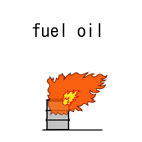| Case Name |
Fire of residual oil during repairing at a fuel oil tank of refinery |
| Pictograph |

|
| Date |
June 4, 1984 |
| Place |
Yokohama, Kanagawa, Japan |
| Location |
Refinery |
| Overview |
Fire broke out after the roof of a heavy oil tank of the refinery was cut using a torch. Although the fire was extinguished once, it occurred again and was reported to the fire station. Although the tank was cleaned before cutting, a considerable amount of oil remained on the steel beams and in the rust scale of the roof. There seemed to be a difference of awareness of safety between the manager and the subcontractor, as well as a lack of communication between them. |
| Incident |
A fuel oil tank at a refinery was opened and was being remodeled. After part of the tank roof was cut by a torch, a fire occurred. Although it was extinguished once, the fire occurred again. |
| Processing |
Storage |
| Substance |
Fuel oil |
| Type of Accident |
Fire |
| Sequence |
The tank was vacated and cleaned to replace heating coils from May 7th to June 1st, 1984.
11:25 on June 4th. A part of the tank roof was cut using a torch.
11:40. Fire broke out.
12:18. Once extinguished, the fire occurred again, and it was reported to the fire station.
14:21. The fire was extinguished with a foam extinguisher. |
| Cause |
Although the tank was cleaned before opening, a considerable amount of oil remained on the steel beams and in the rust scale of the roof. |
| Countermeasures |
1. Hot work should be carried out in the presence of the responsible person of the subcontractor side.
2. Important work including hot work should be carried out by the manager of the refinery bearing the responsibility, or by a responsible person assigned to supervise it. if it is put out to contract.
3. Sufficient time should be spent for both the manager and the subcontractor on checking and confirming safety after the work.
4. Removal of flammable dangerous materials should be ensured before the work. |
| Knowledge Comment |
As subcontractors sometimes are not aware of critical locations and material danger in maintenance, it is necessary to give information to the subcontractors and confirm safety. |
| Background |
Removal of dangerous materials before hot work was insufficient. Extinguishing was not fully ensured. |
| Incidental Discussion |
The tank does not have to be filled with oil up to its upper steel beam or ceiling. Light oil that evaporates during daytime can condense and soak into unexpected places at night.. If the same phenomenon occurred with fuel oil, it is a good lesson to us. |
| Reason for Adding to DB |
A typical accident caused due to hot work near flammables |
| Scenario |
| Primary Scenario
|
Poor Value Perception, Poor Safety Awareness, Inadequate Risk Recognition, Organizational Problems, Inflexible Management Structure, Insufficient Information Transfer, Carelessness, Insufficient Understanding, Insufficient Recognition of Risk, Planning and Design, Poor Planning, Poor Cleaning Planning, Usage, Maintenance/Repair, Decommissioning, Malicious Act, Rule Violation, Safety Rule Violation, Bad Event, Chemical Phenomenon, Burning, Secondary Damage, External Damage, Fire
|
|
| Sources |
High Pressure Gas Safety Inst. of Japan. Tank in a Refinery. Fire of residual oil due to inadequate cleaning under tank repair work. Accident examples of Petroleum refining and Petrochemical unit. pp.81-83(1995)
|
| Physical Damage |
The paint of the tank roof was partially peeled off. |
| Notes |
Cleaning |
| Field |
Chemicals and Plants
|
| Author |
WAKAKURA, Masahide (Kanagawa Industrial Technology Research Institute)
TAMURA, Masamitsu (Center for Risk Management and Safety Sciences, Yokohama National University)
|